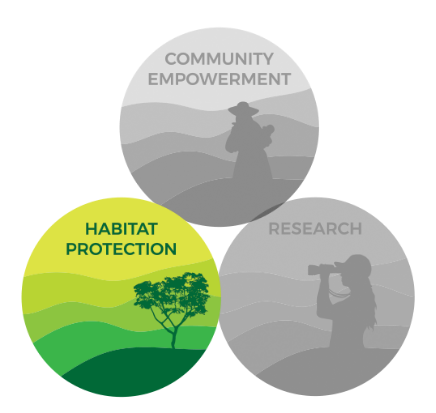<h1>The Best Ways to Protect Natural Habitats in Your Community: A Symphony of Stewardship</h1>
<p>Our communities are more than just concrete and commerce; they are intricate tapestries woven with threads of nature. Protecting these precious natural habitats isn't merely an environmental duty, it's an investment in our collective well-being, enriching our lives with beauty, biodiversity, and resilience. Let's explore some dynamic ways to become custodians of our local ecosystems.</p>
<h2>1. Cultivate Conscious Consumption: Reducing Our Footprint</h2>
<p>Our choices echo through the environment. From the products we buy to the energy we consume, every decision leaves a mark. Embrace conscious consumption to minimize your impact.</p>
<h3>Table: Eco-Swaps for a Lighter Footprint</h3>
<table>
<thead>
<tr>
<th>Instead of...</th>
<th>Try...</th>
<th>Impact</th>
</tr>
</thead>
<tbody>
<tr>
<td>Single-use plastics</td>
<td>Reusable alternatives (bags, bottles, containers)</td>
<td>Reduces plastic pollution, protects wildlife</td>
</tr>
<tr>
<td>Over-packaged goods</td>
<td>Products with minimal packaging or refill options</td>
<td>Conserves resources, less waste in landfills</td>
</tr>
<tr>
<td>Fossil fuel-powered transport</td>
<td>Walking, cycling, public transit, carpooling, EVs</td>
<td>Reduces air pollution, preserves habitats from development</td>
</tr>
</tbody>
</table>
<h2>2. Become a Backyard Habitat Hero: Creating Havens at Home</h2>
<p>Transforming your yard into a sanctuary is a powerful act. Create spaces that welcome native plants, provide shelter, and offer sustenance for local wildlife.</p>
<h3>Table: Backyard Habitat Essentials</h3>
<table>
<thead>
<tr>
<th>Element</th>
<th>Why it Matters</th>
</tr>
</thead>
<tbody>
<tr>
<td>Native Plants</td>
<td>Support local ecosystems and wildlife</td>
</tr>
<tr>
<td>Water Source (Birdbath, pond)</td>
<td>Provides crucial hydration</td>
</tr>
<tr>
<td>Shelter (Birdhouses, brush piles)</td>
<td>Offers refuge from the elements and predators</td>
</tr>
</tbody>
</table>
<h2>3. Embrace Citizen Science: Becoming a Community Detective</h2>
<p>Citizen science empowers everyone to contribute to vital environmental research. By participating in monitoring programs, you become a valuable part of conservation efforts.</p>
<h3>Table: Citizen Science Opportunities</h3>
<table>
<thead>
<tr>
<th>Project Type</th>
<th>Example</th>
</tr>
</thead>
<tbody>
<tr>
<td>Bird Monitoring</td>
<td>eBird, Christmas Bird Count</td>
</tr>
<tr>
<td>Insect Surveys</td>
<td>iNaturalist, Bumble Bee Watch</td>
</tr>
<tr>
<td>Water Quality Testing</td>
<td>Riverkeeper, local watershed groups</td>
</tr>
</tbody>
</table>
<h2>4. Support Local Conservation: Investing in the Future</h2>
<p>Local conservation organizations and land trusts are the guardians of our natural spaces. Supporting them with your time, resources, and advocacy is crucial.</p>
<h3>Table: Ways to Support Local Conservation</h3>
<table>
<thead>
<tr>
<th>Action</th>
<th>Impact</th>
</tr>
</thead>
<tbody>
<tr>
<td>Donate</td>
<td>Funds conservation projects and land acquisition</td>
</tr>
<tr>
<td>Volunteer</td>
<td>Assist with habitat restoration, monitoring, and outreach</td>
</tr>
<tr>
<td>Advocate</td>
<td>Contact elected officials, support conservation policies</td>
</tr>
</tbody>
</table>
<h2>5. Advocate for Sustainable Development: Shaping Our Community's Future</h2>
<p>Development inevitably alters landscapes. Advocate for responsible planning that prioritizes green spaces, protects existing habitats, and minimizes environmental impact.</p>
<h3>Table: Key Considerations for Sustainable Development</h3>
<table>
<thead>
<tr>
<th>Focus Area</th>
<th>Goal</th>
</tr>
</thead>
<tbody>
<tr>
<td>Green Infrastructure</td>
<td>Integrate nature into built environments (parks, green roofs)</td>
</tr>
<tr>
<td>Habitat Connectivity</td>
<td>Create corridors for wildlife movement (greenways, underpasses)</td>
</tr>
<tr>
<td>Smart Growth</td>
<td>Limit sprawl, protect undeveloped land</td>
</tr>
</tbody>
</table>
<h2>Conclusion: A Community in Harmony</h2>
<p>Protecting natural habitats is a collaborative endeavor, a symphony of individual actions that harmonize to create a healthier, more vibrant community. By embracing these practices, we ensure that future generations can also experience the wonder and beauty of our natural world. Let's cultivate a future where nature thrives alongside us, enriching our lives and inspiring a legacy of stewardship.</p>
Additional Information
The Best Ways to Protect Natural Habitats in Your Community: A Detailed Analysis
Protecting natural habitats in your community is crucial for biodiversity conservation, ecological health, and overall community well-being. It involves a multi-faceted approach encompassing policy, community engagement, land management, and financial resources. Here’s a detailed breakdown of the best ways to achieve this, categorized for clarity and depth:
I. Policy & Legislation:
-
Zoning Regulations & Land-Use Planning:
- Detailed Analysis: This is arguably the most powerful tool. Zoning regulations dictate how land can be used (residential, commercial, industrial, conservation), density restrictions, and building setbacks.
- Specific Strategies:
- Establish Conservation Zones: Designate specific areas as protected, restricting development. This often involves purchasing land outright or granting easements (see below).
- Incorporate Green Infrastructure: Integrate natural elements like parks, green roofs, and permeable surfaces into urban planning to mitigate the impacts of development.
- Density Bonuses: Offer incentives (e.g., allowing higher building density) in exchange for developers incorporating green space or contributing to habitat restoration.
- Smart Growth Principles: Advocate for compact, mixed-use development that reduces urban sprawl and minimizes habitat fragmentation. Focus on infill development and re-use of brownfield sites.
- Overlay Districts: Create specific regulations (e.g., requiring native landscaping, limiting light pollution) that apply to areas with sensitive habitats, such as wetlands or forests.
- Challenges: Can face resistance from developers, property owners, and local government officials who may prioritize economic growth over conservation. Requires strong community support and skilled planning professionals.
-
Conservation Easements:
- Detailed Analysis: A legal agreement where a landowner voluntarily restricts the future use of their land to protect its conservation values (e.g., habitat, scenic views). The land remains privately owned, but the easement “runs with the land,” binding future owners.
- Specific Strategies:
- Outreach to Landowners: Educate landowners about the benefits of conservation easements, including potential tax benefits (often in the form of reduced property taxes and estate taxes) and a sense of legacy.
- Negotiation & Drafting: Work with landowners and legal professionals to tailor easements to specific conservation goals, outlining restrictions on development, timber harvesting, etc.
- Monitoring & Enforcement: Ensure that the terms of the easement are followed, often by regular site visits. This requires a dedicated organization (e.g., land trust, government agency) and a funding source for ongoing stewardship.
- Challenges: Requires willing landowners, funding for easement purchase or donation, and ongoing monitoring. Easement terms must be carefully drafted to be legally defensible.
-
Environmental Impact Assessments (EIAs) & Permitting:
- Detailed Analysis: EIAs are required for major development projects to assess potential environmental impacts, including habitat loss and fragmentation. Permitting processes regulate activities that could affect natural resources.
- Specific Strategies:
- Robust EIA Process: Advocate for rigorous environmental impact assessments that consider cumulative impacts (the combined effects of multiple projects), mitigation strategies, and alternative project designs.
- Strict Permitting: Ensure that permits for activities like wetland filling, stream alteration, and timber harvesting are carefully reviewed and enforced.
- Mitigation Requirements: Require developers to mitigate unavoidable habitat loss, such as through habitat restoration, creation of compensatory habitat, or purchasing credits in a mitigation bank (a pre-established area for ecological offsets).
- Challenges: Can be time-consuming and potentially costly for developers, leading to pushback. Requires sufficient staffing and expertise within government agencies to conduct thorough reviews and enforce regulations.
-
Local Ordinances & Policies:
- Detailed Analysis: Local governments can enact ordinances to protect specific habitats or resources, such as:
- Specific Strategies:
- Tree Protection Ordinances: Regulate tree removal, require replanting, and protect mature trees that provide valuable habitat.
- Wildlife Corridors: Establish and protect pathways that allow wildlife to move between fragmented habitats, such as greenways, riparian buffers, and wildlife crossings.
- Water Quality Regulations: Implement policies to protect water resources, which are critical for many habitats. This can include erosion control measures, restrictions on pesticide use, and stormwater management requirements.
- Dark Sky Ordinances: Reduce light pollution, which can disrupt wildlife behavior and navigation, particularly for nocturnal species.
- Challenges: Requires local government support and the ability to effectively enforce the ordinances. May face opposition from businesses or residents concerned about restrictions on their activities.
II. Land Management & Restoration:
-
Habitat Restoration & Enhancement:
- Detailed Analysis: Restoring degraded habitats or enhancing existing ones to improve their ecological function and provide better support for wildlife.
- Specific Strategies:
- Invasive Species Control: Remove and control invasive plant and animal species that outcompete native species and disrupt ecosystem processes.
- Native Planting: Plant native trees, shrubs, and herbaceous plants to create habitat structure, provide food and shelter for wildlife, and improve soil and water quality.
- Stream Restoration: Restore degraded streams and riparian buffers by removing barriers (e.g., dams), re-establishing natural stream channels, and planting native vegetation.
- Wetland Restoration & Creation: Restore or create wetlands to provide habitat for waterfowl, amphibians, and other species, as well as to improve water quality and manage floodwaters.
- Prescribed Burning: Use fire to manage fire-dependent ecosystems, such as grasslands and pine forests, promoting biodiversity and reducing fuel loads.
- Soil Remediation: Address any past contamination, such as polluted soil or groundwater, to make the area habitable.
- Challenges: Can be time-consuming and costly, requiring expertise in ecological restoration. Success depends on proper planning, implementation, and ongoing maintenance. Requires understanding of the specific habitat needs.
-
Sustainable Forestry & Agriculture:
- Detailed Analysis: Implementing practices that minimize the negative impacts of forestry and agriculture on natural habitats.
- Specific Strategies:
- Forestry: Implement sustainable timber harvesting practices, such as selective logging, extended rotation periods, and riparian buffers. Encourage reforestation and conservation of old-growth forests.
- Agriculture: Adopt practices like cover cropping, no-till farming, and integrated pest management to reduce soil erosion, minimize pesticide use, and improve water quality. Create and maintain wildlife-friendly field borders and hedgerows.
- Conservation Easements for Farms & Forests: Offering landowners incentives, such as payment for ecosystem services or cost-sharing programs.
- Challenges: Requires collaboration with landowners, agricultural producers, and foresters. Can be challenging to change established practices.
-
Public Land Management:
- Detailed Analysis: How public lands (e.g., parks, forests, wildlife refuges) are managed has a huge impact.
- Specific Strategies:
- Habitat-Focused Management Plans: Develop comprehensive management plans for public lands that prioritize habitat conservation and restoration.
- Reduce Human Disturbance: Implement measures to minimize human disturbance, such as limiting recreational activities in sensitive areas, controlling access, and reducing noise and light pollution.
- Monitoring & Adaptive Management: Monitor habitat conditions and wildlife populations to track the effectiveness of management practices and adapt them as needed.
- Adaptive Management: Use data and information collected through monitoring to adjust the strategies.
- Challenges: Requires adequate funding, staffing, and expertise. Can involve balancing conservation goals with recreational use and other demands on public lands.
III. Community Engagement & Education:
-
Public Education & Outreach:
- Detailed Analysis: Raising public awareness about the importance of natural habitats and the threats they face.
- Specific Strategies:
- Community Workshops & Events: Host workshops, lectures, nature walks, and volunteer events to educate the public about local ecosystems and conservation efforts.
- Educational Materials: Develop brochures, websites, social media campaigns, and other educational materials that highlight the benefits of habitat conservation and provide information on how individuals can get involved.
- School Programs: Partner with schools to offer environmental education programs, including field trips, classroom activities, and citizen science projects.
- Engage Diverse Audiences: Tailor outreach efforts to reach diverse segments of the community, addressing their specific concerns and interests.
- Challenges: Requires a sustained effort and a variety of communication methods to reach a wide audience. Can be difficult to compete for attention in a crowded information environment.
-
Community Partnerships & Collaboration:
- Detailed Analysis: Working with various stakeholders to achieve common conservation goals.
- Specific Strategies:
- Form Partnerships with Local Organizations: Collaborate with land trusts, conservation groups, universities, businesses, and other organizations to share resources, expertise, and funding.
- Engage with Local Government: Work with local government officials to advocate for policies and programs that protect natural habitats.
- Build Coalitions: Form coalitions of diverse stakeholders to support specific conservation initiatives, building broader community support.
- Involve Local Businesses: Encourage businesses to adopt sustainable practices, provide financial support for conservation projects, and participate in community engagement activities.
- Challenges: Requires strong communication, trust-building, and a willingness to compromise. Can be challenging to coordinate the efforts of multiple organizations.
-
Citizen Science & Volunteerism:
- Detailed Analysis: Engaging the public in collecting data and assisting with habitat conservation efforts.
- Specific Strategies:
- Monitoring Programs: Organize volunteer programs to monitor wildlife populations, water quality, and other indicators of habitat health.
- Habitat Restoration Projects: Engage volunteers in habitat restoration projects, such as tree planting, invasive species removal, and trail maintenance.
- Data Collection & Analysis: Utilize citizen science platforms and online tools to collect and analyze data, contributing to scientific research and informing conservation decisions.
- Challenges: Requires careful planning, training, and oversight of volunteers. Data quality control is important.
IV. Funding & Financial Resources:
-
Grants & Funding Programs:
- Detailed Analysis: Securing funding for habitat protection and restoration projects.
- Specific Strategies:
- Federal & State Grants: Apply for grants from federal and state agencies that support conservation, habitat restoration, and land acquisition.
- Foundation Grants: Seek funding from private foundations that support environmental conservation.
- Local Government Funding: Work with local government officials to allocate funding for habitat protection initiatives.
- Conservation Bonds: Advocate for the issuance of conservation bonds to raise funds for land acquisition, habitat restoration, and other projects.
- Challenges: Grant writing can be competitive and time-consuming. Funding sources may have specific requirements or priorities.
-
Private Donations & Philanthropy:
- Detailed Analysis: Encouraging individuals and businesses to donate to habitat conservation efforts.
- Specific Strategies:
- Individual Giving Campaigns: Launch fundraising campaigns to solicit donations from individuals.
- Corporate Sponsorships: Seek sponsorships from businesses that are interested in supporting environmental conservation.
- Planned Giving: Encourage individuals to include conservation organizations in their estate plans through bequests and other planned giving instruments.
- Challenges: Requires effective fundraising strategies and a strong donor base. Can be challenging to compete for charitable dollars.
-
Tax Incentives & Fees:
- Detailed Analysis: Using tax incentives and fees to encourage habitat conservation.
- Specific Strategies:
- Tax Credits for Land Donations: Advocate for tax credits for landowners who donate land or conservation easements.
- Impact Fees on Development: Implement impact fees on new development to generate revenue for habitat conservation projects.
- Real Estate Transfer Taxes: Allocate a portion of real estate transfer taxes to a fund for habitat acquisition and restoration.
- Challenges: Requires legislative action and can face political opposition. Fees must be carefully structured to be legally defensible.
V. Monitoring & Evaluation:
-
Regular Monitoring:
- Detailed Analysis: Tracking the effectiveness of conservation efforts and making adjustments as needed.
- Specific Strategies:
- Habitat Assessments: Conduct regular assessments of habitat conditions, including vegetation composition, wildlife populations, and water quality.
- Performance Indicators: Establish performance indicators to measure the progress of conservation projects, such as acres of habitat restored, number of invasive species removed, and wildlife population increases.
- Adaptive Management: Use monitoring data to adapt management practices and improve the effectiveness of conservation efforts.
- Challenges: Requires a long-term commitment and dedicated funding. Data collection and analysis can be time-consuming and require specialized expertise.
-
Program Evaluation:
- Detailed Analysis: Assessing the overall success of conservation programs.
- Specific Strategies:
- Periodic Program Reviews: Conduct periodic reviews of conservation programs to assess their effectiveness, identify areas for improvement, and make adjustments as needed.
- Stakeholder Feedback: Solicit feedback from stakeholders, including landowners, volunteers, and community members, to evaluate the effectiveness of conservation efforts.
- Report & Disseminate Findings: Prepare reports on program performance and disseminate findings to the public, government officials, and other stakeholders.
- Challenges: Requires a systematic approach to program evaluation and can be time-consuming. Requires a commitment to transparency and accountability.
Key Considerations for Success:
- Collaboration is Key: Success requires collaboration between government agencies, non-profit organizations, private landowners, businesses, and community members.
- Long-Term Commitment: Habitat protection is a long-term endeavor that requires sustained effort, funding, and political support.
- Adaptability: Environmental conditions and conservation goals change over time, so it’s crucial to be adaptable and adjust strategies as needed.
- Data-Driven Decisions: Base decisions on sound science and data.
- Local Knowledge: Utilize local knowledge and expertise to understand the specific challenges and opportunities facing your community.
- Balance Conservation with Other Needs: Find a balance between conservation goals and the needs of the community, such as economic development and recreational opportunities.
- Celebrate Successes: Acknowledge and celebrate successes to maintain momentum and inspire continued support for habitat conservation efforts.
By implementing a comprehensive and integrated approach that addresses policy, land management, community engagement, and financial resources, communities can effectively protect their natural habitats and ensure a healthy and sustainable environment for future generations. This detailed analysis provides a roadmap for success in this critical endeavor.

